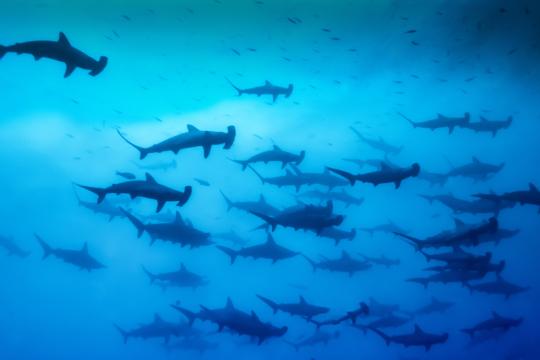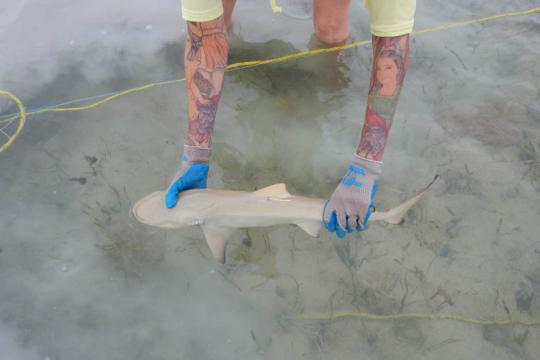White Shark (original) (raw)
 White shark. ©lindsay_imagery, iStock.com.
White shark. ©lindsay_imagery, iStock.com.
White shark. ©lindsay_imagery, iStock.com.
About the Species
The white shark is a large, wide-ranging species that occurs in temperate and subtropical seas worldwide. As an apex predator, the white shark is at the top of the food chain and plays an important ecological role in the oceans. It is also an iconic species due to its occurrence in near-shore habitats and frequent appearance in films and documentaries. But despite its fearsome reputation, its large size and low productivity (reproductive rates, growth rates, age at maturity, longevity, etc.) make the white shark vulnerable to declines from human impacts. Due to these natural vulnerabilities, the white shark is one of the most widely protected sharks globally.
The white shark is also one of the most well-studied shark species in the world, including its populations off the east and west coasts of the United States. Seasonal aggregations in key feeding areas along the coast allows researchers to study them. NOAA Fisheries studies the biology of white sharks as well as monitors their populations and manages fisheries that may incidentally catch them. However, there is still much we don't know about them. Many basic questions about their abundance, life history, habitats, and movements remain unanswered.
Population Status
- The stock status for white shark populations in U.S. waters is unknown and no stock assessments have been completed. No stock assessments are currently planned in the Atlantic.
- Research by NOAA Fisheries scientists indicates that abundance trends have been increasing in the northwest Atlantic since regulations protecting them were first implemented in the 1990s.
- According to a NOAA Fisheries status review and recent research, the northeastern Pacific white shark population appears to be increasing and is not at risk of becoming endangered in U.S. waters.
Appearance
- The white shark gets its name from its white-colored underside but is dark gray to brown on top.
- Like other “mackerel sharks” (mako, porbeagle, and salmon sharks), the white shark has a torpedo-shaped body with a conical snout and a prominent keel at the base of its crescent-shaped tail. The white shark is the largest shark in the mackerel shark family.
- It has a large first dorsal fin, which typically has a pointed apex (tip). There is often a black spot on the underside of the pectoral fins.
- White shark teeth are broad and triangular with distinct serrations. However, the lower teeth are typically more narrow.
Biology
- The white shark grows slowly. Males mature at approximately 26 years old and females at approximately 33 years old. Maximum age is hard to determine and estimates range from 30 to over 70 years old.
- The white shark is born at approximately 4 feet long and can grow up to about 20 feet long, weighing over 4,000 pounds.
- The white shark has a diverse and opportunistic diet of fish, invertebrates, and marine mammals. Juvenile white sharks mainly eat bottom fish, smaller sharks and rays, and schooling fish and squids. Larger white sharks often gather around seal and sea lion colonies to feed and also occasionally scavenge dead whales.
- The white shark is regionally endothermic, meaning it is partially warm-blooded, and can maintain its internal body temperature above that of the surrounding water. This means that it can be a more active predator in cooler waters compared to cold-blooded species.
Where They Live
Range
- The white shark occurs worldwide in temperate and subtropical waters, often migrating seasonally to follow its preferred temperature range (approximately 50 to 80 °F).
- In the U.S. Atlantic, they range from Maine to the Gulf of Mexico and U.S. Caribbean. In the U.S. Pacific, they range from Alaska to California and Hawaii.
- The white shark also lives in waters off the Pacific coast of Mexico.
- There are nursery areas for juvenile white sharks in near-shore waters of southern California and off Long Island, New York.
Habitat
- The white shark occurs in both near-shore coastal waters and offshore pelagic waters.
- Their preferred habitats shift with age. Pups and juveniles tend to remain in near-shore habitats over shallow continental-shelf, in warmer waters. As they age and their diets change, they split their time between seal and sea lion rookeries and pelagic habitats.
Fishery Management
- The white shark is a prohibited species (no retention allowed) in all U.S. waters and fisheries. There are no commercial fisheries for white sharks, but they are occasionally caught as bycatch.
- In the Atlantic, the white shark is managed under the 2006 Consolidated Atlantic Highly Migratory Species Fishery Management Plan. In the Pacific, it is managed by the Pacific Fishery Management Council under the West Coast HMS Fishery Management Plan.
- There are complementary management measures protecting the white shark in state waters along the East and West Coast.
- The white shark is further protected in some of NOAA’s National Marine Sanctuaries.
- The white shark is also protected internationally under CITES Appendix II, CMS Appendix II, UNCLOS, and other international regional fisheries management organizations.
Harvest
This is a prohibited species. White sharks are occasionally caught by recreational and commercial fishermen but must be released immediately.
Scientific Classification
| Kingdom | Animalia |
|---|---|
| Phylum | Chordata |
| Class | Chondrichthyes |
| Order | Lamniformes |
| Family | Lamnidae |
| Genus | Carcharodon |
| Species | carcharias |
Last updated by NOAA Fisheries on 05/08/2024
Featured News

 Heather Moncrief-Cox and researchers from the Southeast Fisheries Science Center examine the body of a deceased white shark. Credit: NOAA Fisheries/Meaghan Emory
Heather Moncrief-Cox and researchers from the Southeast Fisheries Science Center examine the body of a deceased white shark. Credit: NOAA Fisheries/Meaghan Emory
 Previously tagged lemon shark Negaprion acutidens recaptured during survey
Previously tagged lemon shark Negaprion acutidens recaptured during survey

Recreational Fishing Regulations
White sharks are prohibited from being landed by fishermen, but they are occasionally caught by accident in a variety of fisheries for other species. Regulations are currently in place to minimize such bycatch. Additionally, in the Atlantic, recreational fishermen who hold the appropriate permits are allowed to intentionally fish for white sharks with rod and reel gear as long as they release the shark immediately without removing the shark from the water and without further harming the shark.
In the Atlantic, the white shark is managed under the 2006 Consolidated Atlantic Highly Migratory Species Fishery Management Plan. In the Pacific, it is managed by the Pacific Fishery Management Council under the West Coast HMS Fishery Management Plan. There are complementary management measures protecting the white shark in state waters along the East and West Coast.
Last updated by NOAA Fisheries on 05/08/2024
Last updated by NOAA Fisheries on 05/08/2024
Management Overview
The white shark is a prohibited species (no retention allowed) in all U.S. waters and fisheries. The white shark is further protected in some of NOAA’s National Marine Sanctuaries. The white shark is also protected internationally under CITES Appendix II, CMS Appendix II, UNCLOS, and other international regional fisheries management organizations.
In 2012, we conducted a status review in response to a request to list white sharks in the Northeast Pacific as endangered under the Endangered Species Act. We concluded that the listing was not warranted.
White shark among smaller fish. Credit: iStock.com/cdascher.
Management Plans
Last updated by NOAA Fisheries on 05/08/2024
Science Overview
Northeast
NOAA scientists in the Northeast conduct shark life history and long-term monitoring activities essential for stock assessment and management. The majority of the sharks we study are apex predators, at the top of the food chain. The Apex Predators Program was developed to conduct life history research on commercially and recreationally important shark species. We also work on shark surveys and tagging.
Shark research in the Northeast
Southeast
We study the population dynamics of sharks in U.S. Atlantic Ocean and Gulf of Mexico waters, as well as biology, life history, and ecological work.
Shark Population Assessment Group in the Southeast
Alaska
Our vessel surveys combined with fishery observer catch records provide biological information on shark species in Alaska waters. Learn about the Pacific sleeper shark, Pacific spiny dogfish, and salmon shark.
Southwest
NOAA scientists in the Southwest conduct shark life history activities essential for stock assessment and management. The majority of the active research on sharks involves mako, blue, and thresher sharks.
White shark. ©Whitepointer, iStock.com.
Northeast Shark Research
We conduct shark life history research and long-term monitoring activities essential for stock assessment and management.
Last updated by NOAA Fisheries on 05/08/2024
Documents
Research
Northeast Shark Research
We conduct shark life history research and long-term monitoring activities essential for stock assessment and management.
Last updated by NOAA Fisheries on 05/08/2024